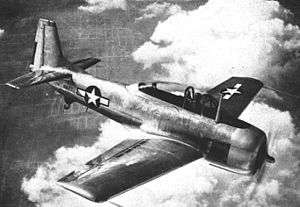North American XSN2J
The North American XSN2J-1, also known by the company designation NA-142, was developed for the United States Navy by North American Aviation as a replacement for the SNJ Texan as an advanced scout-trainer.[1] Designed in competition with the Fairchild XNQ, the XSN2J-1 first flew on 15 February 1947, two aircraft being evaluated by the Navy. Neither aircraft were considered satisfactory in evaluations; in addition, restrictions on the Navy's budget meant that the aircraft could not be ordered at the time, and the program was cancelled in 1948.[2] The similar T-28 Trojan would later be ordered to fill the Navy's requirement for a new trainer.[2]
| XSN2J-1 | |
|---|---|
 | |
| Role | Trainer aircraft |
| National origin | United States |
| Manufacturer | North American Aviation |
| First flight | 10 February 1947 |
| Status | Cancelled |
| Primary user | United States Navy |
| Number built | 2 |
| Developed into | T-28 Trojan |
Specifications
Data from [2]
General characteristics
- Crew: Two (student and instructor)
- Length: 32 ft (9.8 m)
- Wingspan: 41 ft (12 m)
- Wing area: 236 sq ft (21.9 m2)
- Empty weight: 5,500 lb (2,495 kg)
- Gross weight: 7,500 lb (3,402 kg)
- Powerplant: 1 × Wright R-1820-78 Cyclone radial, 1,100 hp (820 kW)
- Propellers: 3-bladed
Performance
- Maximum speed: 270 mph (430 km/h, 230 kn)
- Cruise speed: 190 mph (310 km/h, 170 kn)
- Range: 1,600 mi (2,600 km, 1,400 nmi)
- Service ceiling: 30,000 ft (9,100 m) service
See also

Related development
Aircraft of comparable role, configuration and era
Related lists
References
- "Trainer is Missing Link". Popular Science. New York: Popular Science Publishing Co. 150 (5): 104. May 1947. Retrieved 2017-11-07.
- Johnson, E.R. American Military Training Aircraft: Fixed and Rotary-Wing Trainers Since 1916. Lloyd S. Jones. Jefferson, NC: McFarland & Company. p. 302. ISBN 978-0-7864-7094-5. Retrieved 2017-11-07.
- Silich, Rob. "North American Aviation T-28 Trojan: The Last Great Warbird?" KiwiFlyer Issue 6. New Zealand Warbirds Association.
- Bridges, Derek. SN - Scout Trainer Aircraft, U.S. Military Aircraft and Weapon Designations.
External links
| Wikimedia Commons has media related to North American SN2J. |